My trip to the Dominican Republic (DR) started at 2 am the morning of my flight by a phone call stating that my airport shuttle was ready for me (even though it wasn’t supposed to pick me up until 2:45 am!) That got me up and going at a much faster pace than originally planned but I got to the airport much earlier than I needed, earlier than the check-in staff in fact. Regardless, I got on my flights with no problems and I met up in the Atlanta airport with the group of students from Indiana University I would be working with for the next 12 days (It took me back when a stranger walked up to me while I was waiting at the gate and asked “Are you Michele?” but it turned out to be one of the graduating students, Sam, who helps as an instructor for the course. I felt immediately welcomed and we hadn’t even officially gotten to the DR!).
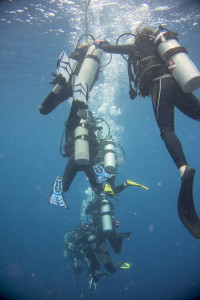
During the Awards Ceremony in April, I had been graciously invited by Dr. Charles Beeker to join him and a group of students from Indiana University for their field work course to the Dominican Republic and I said “yes!” without really knowing what I was getting myself into. Yet here I was, flying to a new country with a group of people I had never met before and I couldn’t be more excited about it. After landing in the capital, Santo Domingo, we took a 1.5 hour bus ride to the town of Bayahibe, where we would be staying for the next 10 days. I had a great chance on the bus to talk and get to know some of the students, many of who reminded me of my classmates and myself during my field courses to Guam and Palau. I was happy to know I would be spending time with students who were excited and eager about the work they were doing.
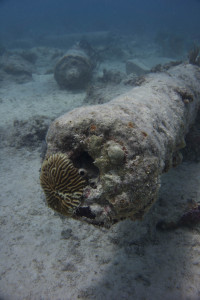
The next few days involved what I would describe as “organized chaos” and lots of hustling and bustling. We spent Wednesday bringing truck loads of gear and equipment from the resort to the dive shop (ScubaFun Bayahibe), where the owner, John, has been supporting IU with this project for several years. We then proceeded to create several historical marker buoys, spar buoys, cut mooring lines, and organize various pieces of equipment needed for the week ahead. After a busy morning, we trucked back to the resort to do a check out dive on the house reef, which also was one of the sites that was to be managed and repaired during the week. It was my first official dive in the Caribbean and I couldn’t be more excited! Everything went quite well and I spent the dive helping some of the instructors survey a line of spar buoys marking the backside of the dive site.
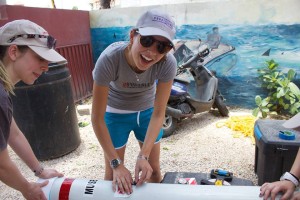
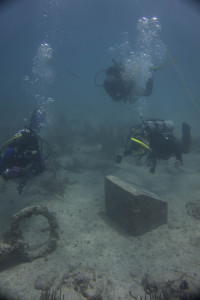
Thursday was started with everyone up and running, getting right into the action. We chartered a boat with ScubaFun for the day to access the Guadalupe Underwater Archaeology Preserve (GUAP site). Even though it was right outside the resort, we had so much gear and equipment, having a boat made it much easier. The students were divided into a variety of groups with specific tasks to accomplish, ranging from the bio team who were surveying the coral and fish life at the site to the archaeology team taking notes on the condition of the cannons and artifacts on site to the maintenance team (who named themselves Seal Team 6) who installed new buoys and repaired those still in the water. We spent the day doing two dives at the GUAP site and got a lot of work done (although some of it needed to be re-done or perfected later in the week).

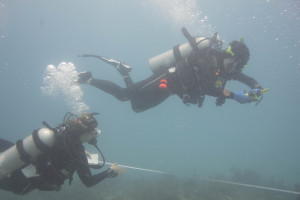
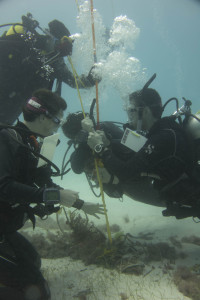
Friday was started with the same vigor and pep as the day before. Thank goodness for the espresso bar at the resort. Again, a boat had been chartered to reach the two sites for the day. We started the morning going to a new location, the Morales site, where a new mooring buoy was to be installed and various assessments were needed to determine site condition. We also went back to the GUAP site for the afternoon to do more work that we didn’t have time to get to the day before. After only two days of diving, I was amazed to see the cannons and artifacts at these sites – cannons that had be dropped from shipwrecks in the 1600’s. So much interesting history lying just below the surface of the water!
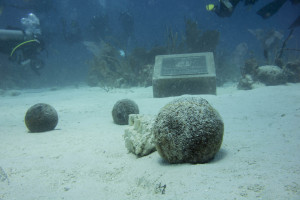
Saturday was a big day – we were headed out to the most famous of the three established Living Museums in the Sea sites – the Captain Kidd shipwreck of the Cara Merchant. We started off with an 11 mile boat ride to Catalina Island (I even got to drive the boat for just a little!) and everyone rode the bow of the big catamaran, enjoying the crystal clear blue waters and eating ripe, juicy mangos brought by the boat operators. We arrived on the site and started off with a deep dive, to help some of the students accomplish part of their Advanced course and to give others more experience with greater depths. After the deep portion, the students went up to the shallow reef where the archaeological site was located and began doing their assessments of the cannons and biology. This site was incredible because there were so many cannons scattered about, some of which you wouldn’t recognize as cannons if you weren’t told they were! After a nice day spent at the site, we motored back to Bayahibe and had a few down hours before going on a night dive at the GUAP site. It was so much fun – lots of interesting critters to see, from octopus to scorpionfish to basket stars to bioluminescence. It was a great dive and we all came up so excited about what they saw. Plus I managed to get a few good pictures from the dive, especially of a pufferfish.
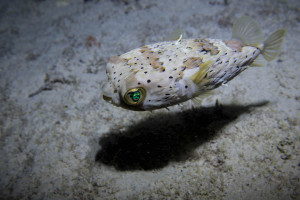
The next morning we were allowed to sleep in a little bit before heading out to a new, vastly different site for the day. Instead of heading to the shore, we headed inland to a site called Padre Nuestro, a beautiful submerged cavern that transitioned into a series of deeper caves. Our focus was the entrance cavern, as this is where many pre-historic artifacts had been found, such as primate and sloth bones, pottery pieces, and even remnants of a fire ring. Being a cavern dive, there was plenty of ambient light from the entrance and the crystal clear waters and geology made for a gorgeous dive. I was with the first small group of students to dive at the site (we had to be divided into 3 groups because the cavern space was quite small) and once we completed our dive, we had the unique chance to go about a mile down the road to visit a second site known as “Chicho” another semi-submerged cavern with pre-historic artifacts.
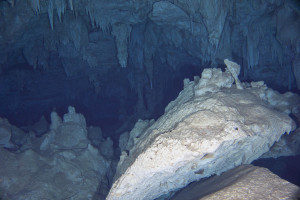
That afternoon, while the students worked on their Rapid Assessments of the sites, I went back out on a boat with Dr. Beeker, Matt, and Billy, who all had one goal in mind: put to use the air powered drill Billy had constructed to cement a couple pins into the seafloor. Billy is a genius in disguise – he practically invented the modern day compressor and has rigged up a drill that is powered only by two scuba cylinders that can be used underwater to bore holes into the seafloor or any hard substrate. But you would never tell by looking at Billy, a man of few words who’d rather smoke his pipe that blow his own horn. Dr. Beeker and Matt were the laborers for the day, and they quickly suited up as we reached the GUAP site and hopped in the water, while Billy commanded the drill from topside. I jumped in the water to watch the process as well as attempt to get some photos. Although they had a few difficulties with weighting at the beginning, once they got going the drill powered through anything. It was really cool to see them able to drill a hole in the seafloor to install a pin to be used for a mooring buoy – the technology is relatively simple and all the parts can be easily acquired at a hardware store.
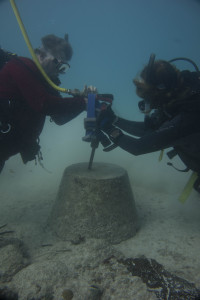
Monday morning we woke up bright and early to catch a bus for a trip to the capital. We were going to the department of submerged resources in Santo Domingo, where IU also has a lab and storage facility where they keep all sorts of equipment and supplies throughout the year. When we arrived at the lab, we were given a tour of the department – from the artifacts submerged in shallow pools to perfectly conserved plates, forks, and shoe buckles. After the look around Dr. Beeker started barking orders to the students, needing one group to clean and organize the inside of the lab and another group to mix cement to form a base for a new dedication plaque. After a few hours of working, the lab was noticeably transformed – new walls set up to make new mini-rooms and a beautiful new plaque to be placed at the site of the Begoña wreck just outside the capital. After a relaxing lunch at a local restaurant called “El Conde” we wandered around the shops for an hour or so before loading back in the bus and heading back to Bayahibe.
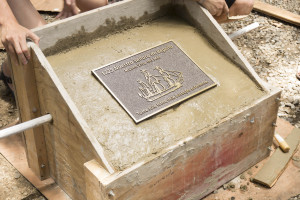
The next day we had to head back out to the GUAP site one last time, to cement in some new ceramics and artifacts, install some new buoys, and perform some last assessments of the biology at the site. Dr. Beeker and Matt also ran the drill once more to complete the hole they started a few days ago and drilled a second hole to allow for even more mooring lines at the site, which is the most popular dive site in the region.
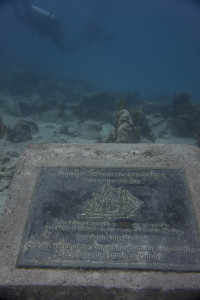
All in all it was a good and busy week. There were lots of meetings, everyone was constantly learning and engaged, and every single student took the work seriously. But at the same time, there were lots of jokes, bonding, and good-natured friendships, and I felt completely accepted and incorporated into the group after just a day of getting to know everyone. I was impressed by the fortitude, knowledge, and enthusiasm of all the students, plus the passion and dedication of the IU staff leading the trip. Although not over yet, we had started the week running hard and planned to go full steam up until we flew out of the Dominican Republic.
